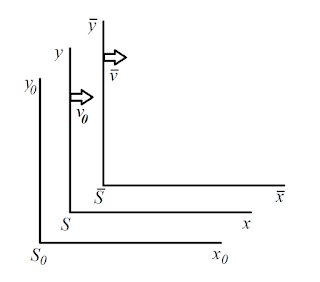Electromagnetic Field Tensor
The idea is to examine how the Lorentz transformation changed the constant electric field generated by infinite uniform charged plates due to length contraction and the constant magnetic field generated by an infinite solenoid due to length contraction and time dilation, along each \(x\), \(y\), \(z\) direction.
\(E_y\) and \(B_z\)
Let \(S_0\) be an inertial frame while \(S\) is another inertial frame moving at speed \(v_0\) along the positive x-axis of \(S_0\) relative to \(S_0\). Consider two infinite plate parallel to the x-axis, each with uniform charge density \(\sigma_0\) and \(-\sigma_0\) respectively in \(S_0\). Then, the electric field within the region between the plates in \(S_0\) is $$\vec{E}_0 = \frac{\sigma_0}{\epsilon_0}\hat{y}.$$ The charge density of the plates is increased in \(S\) because of length contraction $$\sigma=\gamma_0\sigma_0,$$ where $$\frac{1}{\gamma_0}=\sqrt{1-v^2_0/c^2}$$ So, for electric field perpendicular to travel direction \(\vec{v_0}\), $$E^\perp = \gamma_0E_0^\perp.$$ Since there is no length contraction along the direction perpendicular to the \(\vec{v_0}\), we expect $$E^\parallel = E_0^\parallel.$$ In addition, in \(S\), since the plates are moving in the negative direction in \(S\), the surface currents of the positive and negative charged plates are $$\vec{K}_\pm = \mp \sigma v_0 \hat{x}$$ respectively, which means there is a magnetic fields $$B_z=-\mu_0\sigma v_0,$$ pointing in the negative \(z\) direction.
Consider a third inertial frame, \(\bar{S}\), moving at speed \(v\) along the positive x-axis of \(S\) relative to \(S\). Then, from the above arguments, the fields in \(\bar{S}\) are \begin{matrix} \bar{E}_y=\frac{\bar{\sigma}}{\epsilon_0}, & \bar{B_z} = -\mu_0\bar{\sigma}\bar{v}, \end{matrix} where \(\bar{v}\) is the relative speed of \(\bar{S}\) relative to \(S_0\), $$\bar{v}=\frac{v+v_0}{1+vv_0/c^2}$$ and \begin{matrix} \bar{\sigma}=\bar{\gamma}\sigma_0, & \bar{\gamma}=\frac{1}{\sqrt{1-\bar{v}^2/c^2}}. \end{matrix} In terms of \(\sigma\), the fields are \begin{matrix} \bar{E}_y=\left(\frac{\bar{\gamma}}{\gamma_0}\right)\frac{\sigma}{\epsilon_0}, & \bar{B_z} = -\left(\frac{\bar{\gamma}}{\gamma_0}\right)\mu_0\sigma\bar{v}. \end{matrix} Work out \(\left(\frac{\bar{\gamma}}{\gamma_0}\right)\), $$\frac{\bar{\gamma}}{\gamma_0}=\frac{\sqrt{1-v^2_0/c^2}}{\sqrt{1-\bar{v}^2/c^2}}=\frac{1+vv_0/c^2}{\sqrt{1-v^2/c^2}}=\gamma\left(1+\frac{vv_0}{c^2}\right).$$ Then, in terms of \(E\) and \(B\), the fields in \(\bar{S}\) are $$\bar{E}_y=\gamma\left(1+\frac{vv_0}{c^2}\right)\frac{\sigma}{\epsilon_0}=\gamma\left(E_y-\frac{v}{c^2\epsilon_0\mu_0}B_z\right)=\gamma(E_y-vB_z)$$ and $$\bar{B}_z=-\gamma\left(1+\frac{vv_0}{c^2}\right)\mu_0\sigma\left(\frac{v+v_0}{1+vv_0/c^2}\right)=\gamma(B_z-\mu_0\epsilon_0vE_y)=\gamma\left(B_z-\frac{v}{c^2}E_y\right),$$ since \(\mu_0\epsilon_0=1/c^2\).
\(E_z\) and \(B_y\)
If we change the uniform charged plates from parallel to the \(yz\) plane to parallel to the \(xy\) plane, using similar arguments, since the setting is that the electric field is along the positive \(z\) direction, electric field in \(S\) is $$E_z=\frac{\sigma}{\epsilon_0},$$ while the plates are also travelling to the negative x-axis direction, the direction of the magnetic field along the y-axis becomes positive $$B_y = \mu_0\sigma v_0.$$ Then, the fields in \(\bar{S}\) are \begin{matrix} \bar{E}_z = \gamma(E_z + vB_y), & \bar{B}_y = \gamma\left(B_y+\frac{v}{c^2}E_z\right). \end{matrix}
For the \(x\) direction, the electric fields remain the same because of no length contraction. Consider an infinite solenoid at rest, the magnetic field within the coil is $$B_x = \mu_0nI,$$ where \(n\) is the number of coil per unit length and \(I\) is the current. In \(\bar{S}\), the number of coil per unit length is increased due to length contraction $$\bar{n}=\gamma n,$$ while the current is decreased due to time dilation $$\bar{I}=\frac{1}{\gamma}I.$$ Thus, the overall magnetic field in the \(x\) direction remains the same.
In conclusion, $$\bbox[5px, border: 2px solid #666]{ \begin{matrix} \bar{E}_x = E_x, & \bar{E}_y = \gamma(E_y-vB_z), & \bar{E}_z = \gamma(E_x+vB_y)\\ \bar{B}_x=B_x, &\bar{B}_y = \gamma\left(B_y+\frac{v}{c^2}E_z\right), & \bar{B}_z=\gamma\left(B_z-\frac{v}{c^2}E_y\right) \end{matrix} }\tag{1}$$
Field Tensor
We might put our result into a second-rank tensor. For a 4-vector, a first-rank tensor, the Lorentz transformation is given by $$\bar{a}^\mu = \Lambda^\mu_\nu a^\nu,$$ where \(\Lambda\) has the form \begin{pmatrix} \gamma & -\gamma\beta & 0 & 0 \\ -\gamma\beta & \gamma & 0 & 0 \\ 0 & 0 & 1 & 0 \\ 0 & 0 & 0 & 0 \end{pmatrix} For a second-rank tensor, two fractors of \(\Lambda\), one for each index of the second-rank tensor $$\bar{t}^{\mu\nu}=\Lambda^\nu_\lambda\Lambda^\nu_\sigma t^{\lambda\sigma}.$$ If we define the field tensor as $$F^{\mu\nu}=\begin{pmatrix} 0 & E_x/c & E_y/c & E_z/c \\ -E_x/c & 0 & B_z & -B_x \\ -E_y/c & -B_z & 0 & B_x \\ -E_z/c & b_y & -B_x & 0 \end{pmatrix},$$ we will get back (1) when we apply Lorentz transformation. The dual field tensor, $$G^{\mu\nu}=\begin{pmatrix} 0 & B_x & B_y & B_z \\ -B_x & 0 & -E_z/c & E_y/c \\ -B_y & E_z/c & 0 & -E_x/c \\ -B_z & -E_y/c & E_x/c & 0 \end{pmatrix},$$ can also generate the tranformation rule for \(\vec{E}\) and \(\vec{B}\).
Current Density 4-vector
The proper charge density \(\rho_0\) is the charge density in the rest frame of the charge $$\rho_0 = \frac{Q}{V_0}.$$ In other inertial frames, the volume is squeezed because one of the dimension is Lorentz-contracted $$V=\sqrt{1-u^2/c^2}V_0.$$ So, the charge density is $$\rho = \rho_0\frac{1}{\sqrt{1-u^2/c^2}},$$ and the current density is $$\vec{J}=\rho_0\frac{\vec{u}}{\sqrt{1-u^2/c^2}}.$$ As we can identify the four-velocity component in these two expression, we want to group them to form a 4-vector, $$J^\mu=\rho_0 U^\mu.$$ This is called the four-current density.
4-vector Potential
Define the 4-vector potential as $$A^\mu=(V/c,A_x,A_y,A_z).$$ Then, the field tensor can be written as $$\bbox[5px, border: 2px solid #666]{ F^{\mu\nu}=\frac{\partial A^\nu}{\partial x_\mu}-\frac{\partial A^\mu}{\partial x_\nu} }$$





Comments
Post a Comment